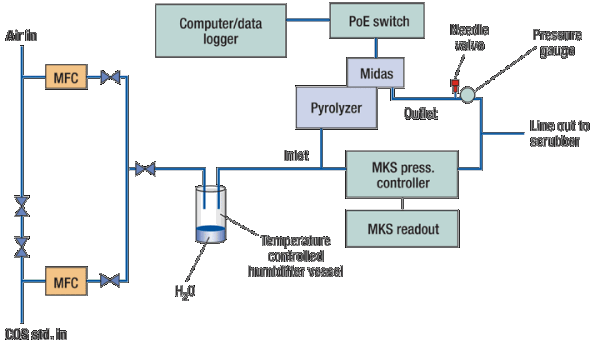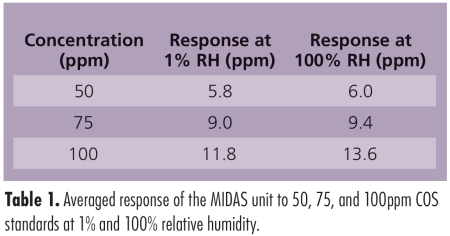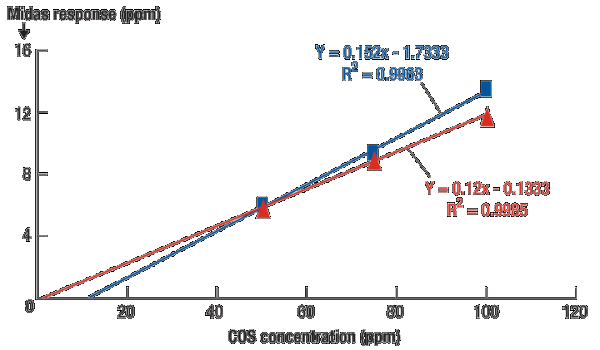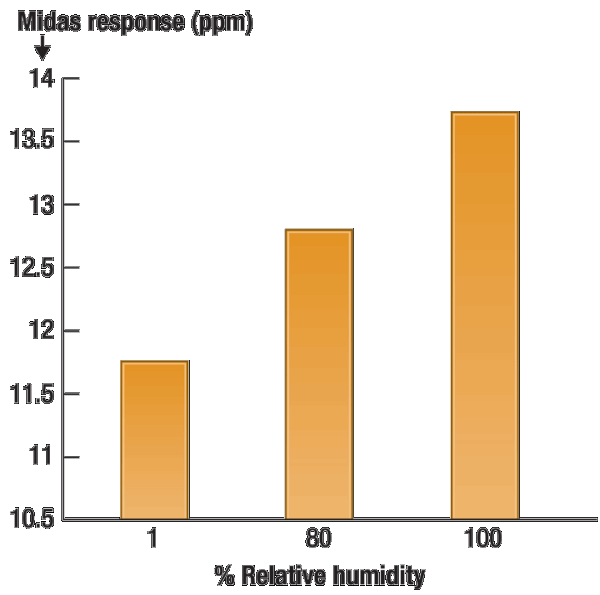|
Executive Overview A pyrolyzer-electrochemical cell-based sensor (MIDAS) gas detector, Honeywell Analytics) has been tested for its ability to detect carbonyl sulfide (COS) in ambient air. The unit employs pyrolysis to initially convert COS to hydrogen sulfide (H2S) in the presence of ambient moisture and subsequently measures the H2S response using an electrochemical sensor cartridge. The sensor proved to be linear in the range tested (50-100ppm) with a response ranging from 12-14% of the COS concentration depending upon relative humidity (RH). A 15% increase in response was observed as relative humidity increased from 1 to 100%. |
Dan Chase, Joe Vininski, Mark Raynor, Matheson Tri-Gas Inc., Longmont, CO USA
Carbonyl sulfide (COS) is a gas that is being increasingly used for new industrial applications, including semiconductor etch processes. COS is a colorless gas, and like hydrogen sulfide, causes respiratory paralysis and targets the central nervous system. The chemistry and properties of COS have been reviewed by Svoronos and Bruno [1]. Since the odor warning properties of carbonyl sulfide are not as prominent as those of hydrogen sulfide, monitoring of cylinder fill or storage locations is important to alarm workers in the event of a gas leak or release. However, to date, low cost COS sensors have not been available for ambient air monitoring. Therefore, we have recently conducted evaluation tests at Matheson Tri-Gas on a pyrolyzer-electrochemical cell-based sensor (MIDAS gas detector, Honeywell Analytics) for monitoring COS gas concentrations.
This unit is a toxic and flammable gas detector providing response to the presence of many of the gases used or generated in the semiconductor/high-tech manufacturing industry. It is typically used to monitor process tools, gas cabinets, valve manifold boxes (VMBs), ambient air and other areas where gases are generated as part of the manufacturing process, or a by-product of it. It was designed to serve a wide range of installation scenarios, from those requiring a single point of detection to those requiring a thousand or more. The detector is compact, measuring 63mm (W) x 150mm (D) and weighs 0.41kg and uses a pump to continually draw air into the system for measurements. Therefore, units can be placed outside of the area where gases are generated (e.g., a safe room). Although in our work, an H2S sensor was used, the cell-based sensor can accept 23 different sensor cartridges, many with built-in cross-sensitivities to detect other gases (over 40 semiconductor gases, in all). The sensors include a built-in sensor cell self-checking diagnostic tool that indicates sensor performance.
Continuous, real-time monitoring of toxic gases takes place using power over ethernet (PoE), which combines data and electrical transmission on a single cable with gas concentration and other critical values. Data is transmitted via LonWorks, ModBus/TCP/IP communications systems, or is viewable on the local display. Data provided by the analyzer includes gas events, gas type, gas concentration, calibration due and many other values for fault diagnostics, maintenance scheduling and other requirements. An internal web browser enables access of information such as the last 50 safety events (gas alarm, sensor calibration, Modbus configuration and service requirements).
In our tests, an H2S sensor was evaluated for response to COS in the 50-100ppm range with the aim of using it for ambient monitoring. Because COS is detected by conversion to H2S in the presence of moisture, the effect of humidity on the response was also tested.
Experimental procedure
The gas handling system and experimental set-up used to test the pyrolyzer-H2S electrochemical sensor combination for response to carbonyl sulfide is shown in Fig. 1.
 |
| Figure 1. Schematic of the experimental set-up, showing gas handling system and connections for data handling. |
Electrical connections. The monitor can be powered by either 24VDC via traditional discrete wiring or by ~48VDC delivered through the Ethernet cable delivered from a PoE source. For our application, we opted to use the PoE option for ease of installation and for the added controls afforded by the internal web browser. A Netgear model FS108PNA, 8-PRT 10/100+4-PRT PoE switch was used to power the detector and to interface it to a personal computer.
Sampling system. The gas detector uses an internal pump to draw in the gas sample. This is fed through a pyrolyzer, which, at high temperature and in the presence of moisture, converts COS to H2S. The exhaust H2S is measured by means of an electrochemical sensor cartridge. Hydrogen in this reaction is supplied by moisture in the air and it was therefore necessary to control the relative humidity for the reaction. A heated vessel was installed in-line just before the inlet and thermally controlled to deliver a consistently humidified gas stream from headspace. To control vessel temperature, a thermocouple was attached to the vessel which was then wrapped in heat tape. A variac coupled to a PID was used to measure and control the temperature of the vessel. Humidity levels were measured at the gas detector inlet using a Mannix digital psychrometer capable of measuring relative humidity and air temperature. A vessel temperature of 25°C (measured by the PID) was used to achieve a relative humidity (RH) of 1% and a vessel temperature of 50°C was used to achieve a relative humidity of 100%. The incoming gas stream was passed into the vessel, over the top of the water for humidification, through the pyrolyzer and on to the sensor cartridge.
The response of the sensor to COS was tested at concentrations of 50, 75, and 100ppm, each at 1% and 100% RH. A certified 100ppm COS standard in a UHP grade nitrogen balance (Matheson Tri-Gas) was used for this purpose. Purified house air was used for dilutions. If the total flow from either the COS cylinder or the combined COS/air dilution exceeded 600sccm, the inlet pressure could not be sufficiently controlled resulting in high flow rates for the MIDAS (over 500sccm). For this reason, care was taken to keep total flows to a maximum of 600sccm. Two 500sccm MKS mass flow controllers were used to control COS and purified air flow rates.
Because the unit was designed to operate at atmospheric pressure, pressure controls were installed before the inlet and after the exhaust allowing for the pressure to be held at 760torr. An MKS type 640 pressure controller was used to control the inlet pressure. A needle valve and pressure gauge were used to control the exhaust pressure. With the pressure controller set to 760torr, the needle valve was adjusted (opened or closed) until the required pressure could be met. At 760torr, the internal pump introduced sample into the pyrolyzer-electrochemical cell at a rate of 500sccm ± 5sccm.
Results and discussion
Standards were run at concentrations of 50, 75, and 100ppm at 1% and 100% relative humidity to determine linearity and response of the detector. Table 1 shows the results of these experiments.

The length of the inlet line from the COS gas standard cylinder to the inlet of the unit was approximately 3 meters and the associated response time for the MIDAS unit was ~5s. The response of the monitor became steady at ~3min and readings were taken at 5min. Beyond 5min., no change in response was observed. The responses reported were taken as an average of 3 separate readings.
 |
| Figure 2. Plot of response versus COS concentration at 1% relative humidity (red triangles) and 100% relative humidity (blue squares). |
Figure 2 shows the instrument response plotted against concentration at both 1% and 100% relative humidity. Linearity is sufficient for both and response is slightly greater at higher relative humidity. Based on the measurements, we predict that the lowest detectable COS concentration is in the region of 20ppm.
 |
| Figure 3. Response to a 100ppm COS standard with varying relative humidity. |
A 100ppm standard was run at 1, 80, and 100% RH to determine the effect on response. As shown in Fig. 3, the response of the MIDAS unit to a 100ppm COS standard continues to increase as the relative humidity increases. The response increased by 15% as the relative humidity increased from 1 to 100%.
Conclusion
As COS is being increasingly used in industrial and semiconductor manufacturing processes, low cost ambient air monitoring is required. A pyrolyzer-electrochemical cell-based sensor has been tested and shown to be capable of detecting COS (as H2S) in the range of tens of ppm up to 100ppm. The conversion of COS to H2S in the pyrolysis unit is affected by the relative humidity and the detector should therefore be calibrated on site or at the same relative humidity range as the site of operation for highest accuracy. A response ranging from 12-14% of the actual concentration can be expected.
Acknowledgment
MIDAS is a registered trademark of Honeywell Analytics.
Reference
1. P.D.N. Svoronos and T.J. Bruno, "Carbonyl Sulfide: a Review of Its Chemistry and Properties," Ind. Eng. Chem. Res. 41, pp. 5321-5336 (2002).
Biographies
Dan Chase received his BS and MS degrees in chemistry from the U. of Colorado, Boulder, CO and is a senior research scientist at Advanced Technology Center, Matheson Tri-Gas Inc., 1861 Lefthand Circle, Longmont, CO, 80501 USA; ph.: (303) 678-0700; email [email protected].
Joe Vininski received his BA in chemistry from Saint Olaf U., Northfield, MN and is a manager, of applied technology at Matheson Tri-Gas Inc.
Mark Raynor received his BSc Hons. degree in chemistry from the U. of Natal, Durban, South Africa, and his PhD in physical chemistry from the U. of Leeds, Leeds, UK, and is R&D Director, gas development and analytical technology at Matheson Tri-Gas Inc.
More Solid State Technology Current Issue Articles
More Solid State Technology Archives Issue Articles


I manufacture electrochemical gas generators that are used to calibrate gas detectors and was wondering if there may be a fit with my instruments with this equipment since it uses the ambient air in the area and adds H2S to it which your paper indicates would be the preferred method. I was also wondering what type of pyrolyser you used and what temperature it took to convert the COS to H2S.